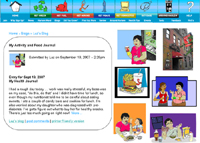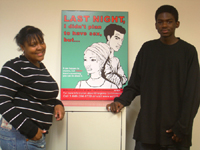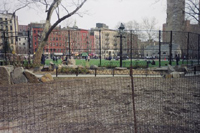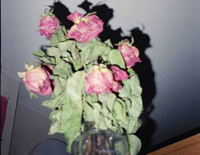On This Page
More Information
New Media Bridge the Harlem Health Divide
March 2008

The character Luz represents women in Harlem concerned about their health.
In the mid-1920s, Harlem, New York, became known as a hub of black culture
and expression, through music, dance, literature, poetry, and storytelling.
Now, words and pictures zip along WIFI networks and across cell phone towers
throughout this predominantly African-American and Hispanic neighborhood.
Harlem is plugged in and turned on. And public health researchers are using
the electronic avenues to share health-promoting information with residents,
while using traditional Harlem creativity and style.
Meet Luz, a fictional resident who shares her story on GetHealthyHarlem.org, the cornerstone of a multimedia approach to health promotion led by Columbia University's Harlem Health Promotion Center at the university's Mailman School of Public Health. Now under construction, the Harlem-specific Internet health resource is being designed to provide information and bring neighbors together to discuss common health issues.
In a series of written episodes, Luz, who has hypertension, faces the
temptation of street pastry vendors and the obstacle of climbing
flights of stairs without running out of breath. Her mother
smokes and her daughter has asthma and diabetes. As her story progresses,
Luz will learn to decrease her stress, start exercising, and make better
food choices. She will also learn about health centers such as the Naomi Berrie Diabetes Center in Northern Manhattan. The stories and characters
were tested by focus groups in Harlem to ensure authenticity and relevance.
"You can go to my profile to learn more about me and how I use this web site to get healthier," Luz tells readers. "This is a great place to get
connected to other people in Harlem who are interested in health—just like
you!"

GetHealthyHarlem.org invites users to learn about health resources in Harlem and explore options of the web site. Enlarge picture.
To reach residents, the center is using several media, including cell phone text messages and photography as well as the Internet.
In a 2005 study, the center found that 65% of Harlem's 260,000 residents used the Internet, and half of the non-users wanted to start, confirming that the "digital divide" was closing in Harlem. The digital divide describes the gap between people with access to information technology and people without it—often people in poor or minority communities. Harlem is about 67% African American and 20% Hispanic, and the median yearly household income of about $20,000 is roughly half the national figure.
Researchers hypothesized that new media might be one way to provide support for bridging other divides in Harlem, such as a higher-than-average prevalence of asthma, heart disease, cancer, HIV infection, and smoking. But researchers say that health information found online is rarely targeted for specific geographic or ethnic communities, especially African American and Latino audiences.
"On the web, we don't see images of ourselves," said community advisory board member and former New York state health department official Goldie Watkins-Bryant.
The 2005 study showed an opening for a web site: 71% of Harlem Internet users said they trust the Internet for health information. About a third reported they had used the Internet for information about diet, nutrition, or exercise, and a third had used the Internet to find information about medical problems or treatments. Although respondents reported enjoying the freedom that the Internet allowed, many expressed difficulty understanding information found online.

The web site links to resources that can help users. This page includes lists that were developed by the New York City Department of Health. Users can navigate to that site as well as information about nutrition, stress management, exercise, networking, and other local resources. Enlarge picture.
- Information about local health clinics and their hours and services
- Reputable links and resources for learning about conditions common in Harlem
- Columns by local health providers
- An event calendar where walking groups and health festivals can be posted
- News about health and Harlem
- A social networking component
Center Director Alwyn Cohall, M.D., says the digital age enhances public health work. Even if some of the health messages are the same as in the past, the Internet allows them to reach more people, faster.
"It takes a lot of work, time, and effort to get 10 or 20 people in a room to do a 6-session [traditional public health] intervention," Dr. Cohall said. "I was looking for a way to get information and support out to customers as effectively and efficiently as possible."
The site's designers have made it interactive so that users can put their
own stamp on the site and feel ownership. Users will be able to create
profiles, post news, write blogs, post videos and music about their own
health and lives, and get feedback from others. This interactivity,
described as "Web 2.0," will reinforce messages and provide extra support
for people seeking to improve health behaviors, according to the
researchers. Researchers will monitor postings in the interactive part of
the site but only remove a post if it is potentially harmful.
This spring, a pilot study will measure the effectiveness of the web site
with 300 volunteers aged 18-65. Researchers will measure participants' use
of the site over 6 weeks, as well as users' knowledge about the web site and
its health resources, their attitudes and intentions to change health
behavior, and actual behavior change three and six months later.

The story of Luz gives users a personal perspective on the obstacles to staying healthy in Harlem. Enlarge picture.
The center is also working with a technology firm to develop software for secure personal electronic health records. Eventually these records will be integrated with the site, allowing for personalized information and advice along with other, yet-to-be-imagined services.
"I'm very excited about it," said Rita Kukafka, Dr.P.H., co-principal investigator of the center, who is leading the design of the web site architecture. "This web site is a little bit different from a traditional web site and it makes use of a whole different generation of what the Internet can do."
Community health providers say their clients are not only ready for such a site but that it would fill a void.
"I'm always trying to reinvent the wheel," said Katherine Fichtel, a librarian at Settlement Health Center, a primary care center in East Harlem. "I'm always looking for new, community-specific resources. The idea we could get it all in one place, that is ideal."
Researchers say it is realistic that Harlem residents may not know about resources available in their community, because people are busy with work and New York is so densely populated. Even if they know of the resources, they may not know the specific services they provide.
"The thing that hit me is being able to find out when the doctor's office is open," said Emma Chapman. "When people are home sick, they think, ‘If I go to the emergency room, I'm going to be there all night.' Here you can find a doctor that is open Saturday or Sunday. It fits into your life." Ms. Chapman runs a nonprofit organization, Health for Success, to help doctors speak to community members.
In Luz's story, she has a relapse of bad habits after rain keeps her from going to her walking group and a new supervisor brings in donuts and muffins to work every day. She makes a post on GetHealthyHarlem.org and writes about her experiences. Within a day or so, she gets several responses encouraging her to resume exercise and healthy eating. Researchers hope real users of the site will respond to others in similar ways.
"We are hoping [the site] will become a movement," Dr. Cohall said. "As more and more people get this information—about walking groups and places to go for health checkups—they will make healthy choices. Our vision is the site would be the home page for every resident in Harlem."
The Harlem Health Promotion Center uses other digital media as well to combat public health problems. Here are some examples.
Cells & The City

In "Cells & The City" videos, animated cell phones are shown text messaging each other about sexual health, using slang to appeal to a young urban audience. In this video, a friend urges another to be tested for HIV. Enlarge picture.
The videos, part of the "Cells & The City" project, use computer animation and depict phones as characters that are texting each other about health issues like using condoms or getting tested for sexually transmitted infections. The messages are kept current by using the latest slang to connect with the audience—urban teens and young adults. Each video lasts about three minutes, or the length of one conversation. The videos show text appearing on a phone screen and also carry a voiceover reading the messages.
Mr. Ford works with teenagers to help them create the short videos. Dr. Cohall of the Harlem Health Promotion Center recruited Mr. Ford to work with youths who are associated with the center's Project STAY, a resource center and clinic for HIV-positive young adults.
The teens review pages of icons of different types and brands of cell phones to choose cell phone characters for their videos, choose background music, write scripts, and program the animation.
The videos are then shared online and can be downloaded to portable media devices, Mr. Ford said. They have become popular overseas, he said. He's already seen some of the first episodes he created shared online by people in England.
Abbott Laboratories** provided initial funds to the Harlem Health Promotion Center to develop the project. Recently, Dr. Cohall and the New York City health department received a federal grant to create more Cells & The City vignettes about teen pregnancy and sexually transmitted infections.
Thai-Rae Williamson, a teenager who worked with Mr. Ford on a previous project to create Cells & The City episodes for the school system, said the format attracts teens and encourages them to listen.
"It will automatically capture their attention because that's the way we speak, that's our language," she said. "We're going to pay attention as if they are talking to us. We love text messaging. We got our own little lingo and all that."
Harlem Movie Stars

Shannon Holder and Benjamin Tompkins, actors in "My Life, My Decision," stand next to the movie poster the youth advisory board helped design. Enlarge picture.
The Harlem Health Promotion Center received a grant from the New York City Department of Health and Mental Hygiene to make a movie to teach teenagers about emergency contraception.
The center recruited local teens to help develop storylines for, act in, and help market the film, "My Life, My Decision," which presents three interweaving storylines about young couples who learn about and use emergency contraception pills, also known as "plan B," that can prevent pregnancy up to five days after sex. A local filmmaker, Hanif Shabazz, who is on the center's advisory board, directed and edited the movie.
Teens on the youth advisory board made sure the characters spoke like teens in Harlem and found humor in characters teasing each other about relationships. On the serious side, the movie encourages open discussion among teens and parents.
The film is shown as part of the center's outreach activities at youth centers and high schools. Segments of the film will also be posted on a web site the center developed, also with grant money from the city, www.ec123.org*, to educate Harlem teens about emergency contraception. Segments of the DVD are online on the video-sharing web site YouTube. The DVD is available for health providers and community groups.
Mr. Shabazz, executive producer of a community-based documentary and filmmaking production company, said he was looking for a way to use his skill to help improve health in Harlem.
"[Mr. Shabazz]'s experience, talent, and love for the community are evident in the quality of the film," Dr. Cohall said.
Benjamin Tompkins, 19, who acted in the film, said working on the movie inspired him to choose a major of health education in college. He and the rest of the team spent weeks planning for the movie and helping design movie posters that would attract attention.
"You had to think, if I were to walk by [the poster] on the street, would I look at it or would I keep walking?"
As with the web site, making the information local and relevant was important. The video shows specific pharmacies in Harlem where emergency contraception is available and real clinics to visit for more information.
"I was pleasantly surprised," said Christen Pruitt, a tutor at a youth center where the video was shown. "I thought it was great that it's local and not some obscure place with random people."
Photos of Feelings

The young woman who took this picture said she feels like she is behind a fence, looking at life happening beyond her reach. Enlarge picture.
The photos are part of a "Photovoice" project offered by the Harlem Health Promotion Center. The Photovoice technique was developed by public health researchers in the early 1990s to help enable women in rural China influence policies and programs that affected them. Since then, it has been used throughout the world to help strengthen the voice of people in many communities.

The young man who took this photo said his life as an HIV-positive teenager is like a path where he cannot see the ending. Enlarge picture.
"Photovoice opened my eyes to photography," said "Sugar," a participant who used her nickname because she prefers to remain anonymous. "It made me reflect more about the situation that I am in. The pictures made it easier to talk."
Joyce Moon-Howard, Dr.P.H., a professor in Columbia University's Mailman School of Public Health, and a co-director of the Harlem Health Promotion Center, brought the technique to the center several years ago. She said when photos are shared, the connections made during discussions can lead to innovative ways to overcome obstacles and barriers.
"Solutions the community comes up with because they see the pictures are different from the solutions researchers come up with when they see the data," she said. "A picture gives context for the data. It gives an ability to have a common, shared meaning for something."
Participants received memory books of everyone's photos, which will also be exhibited at a local children's hospital, said Doris Roman, a social worker for the center who led the project.
Sugar said the experience helped improve her outlook on living with HIV.
"It makes you feel like you're not alone," she said. "When you get together
and talk about the pictures, it makes you feel you're not the only one going
through this."

The HIV-positive young person who took this photo said he feels like a
pile of garbage, tossed aside by society.
Enlarge picture.

The photographer of this photo, an HIV-positive young person, said,
"These flowers represent how I feel sometimes, on the outside. I may
look beautiful and pretty but on the inside I feel tired, wilted and
sad. Sometimes this gets in my way." Enlarge picture.

The photographer of this image said trees with no leaves represent the scary times that happen when living with HIV. Enlarge picture.

The young woman who took this picture said that being HIV-positive is like having a stop sign in front of her when all of her friends her age have green lights. Enlarge picture.
* Links to non-Federal organizations are provided solely as a service to our users. This link does not constitute an endorsement of this organization by CDC or the Federal Government, and none should be inferred. The CDC is not responsible for the content of the individual organization Web pages found at this link.
![]() One or more documents on this Web page is available in Portable Document Format
(PDF). You will need Acrobat
Reader (a free application) to view and print these documents.
One or more documents on this Web page is available in Portable Document Format
(PDF). You will need Acrobat
Reader (a free application) to view and print these documents.
- Page last reviewed: February 13, 2008
- Page last updated: March 31, 2008
- Content source: Division of Adult and Community Health, National Center for Chronic Disease Prevention and Health Promotion
Get email updates
To receive email updates about this site, enter your email address:
Contact Us:
- Prevention Research Centers
4770 Buford Hwy, NE
MS K-45
Atlanta, GA 30341-3717 - cdcinfo@cdc.gov

